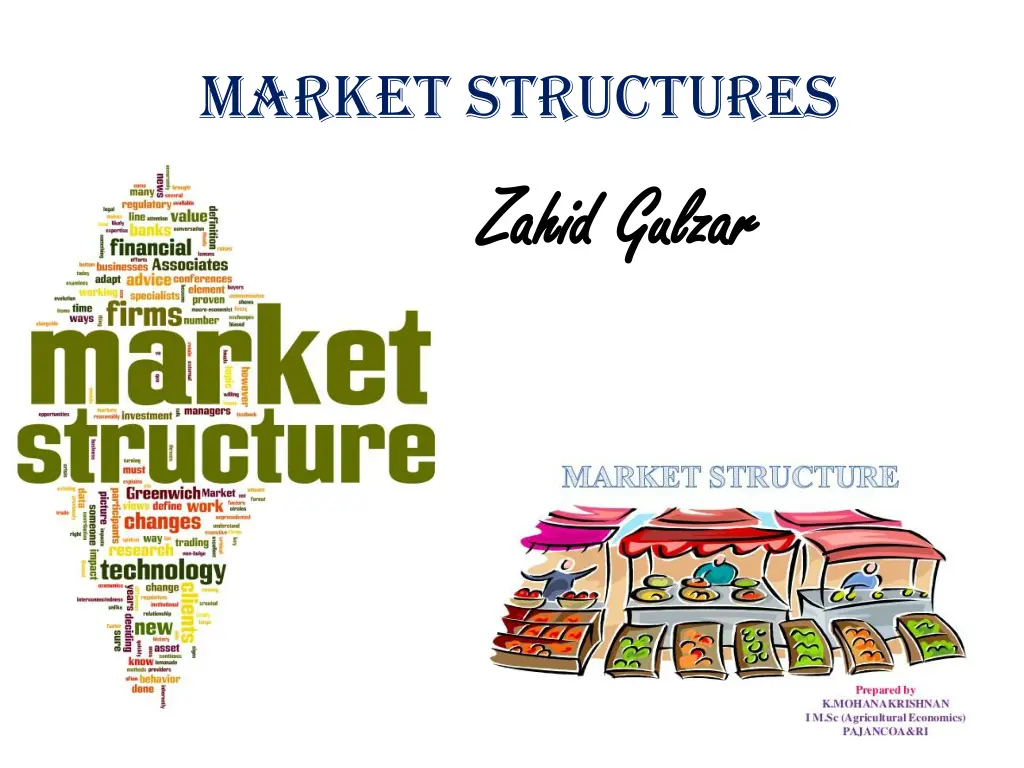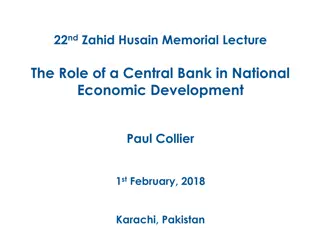
Market Structures and Definitions in Economics
Explore various market structures, classifications, perfect competition features, firm equilibrium, industry equilibrium in the short run, and more in economics. Understand the concepts of buyers, sellers, demand, supply, and market interactions.
Download Presentation

Please find below an Image/Link to download the presentation.
The content on the website is provided AS IS for your information and personal use only. It may not be sold, licensed, or shared on other websites without obtaining consent from the author. If you encounter any issues during the download, it is possible that the publisher has removed the file from their server.
You are allowed to download the files provided on this website for personal or commercial use, subject to the condition that they are used lawfully. All files are the property of their respective owners.
The content on the website is provided AS IS for your information and personal use only. It may not be sold, licensed, or shared on other websites without obtaining consent from the author.
E N D
Presentation Transcript
Market Structures Zahid Zahid Gulzar Gulzar
Market in Economics Market in Economics No reference to a particular place The buyers & sellers need not assemble anywhere An ordinary post, telephone, mail can serve the channel Commercial interaction Matching of demand and supply Same things, Same price, Same time
Definition Definition A market implies an interaction between a buyer and a seller at a point in time so that the transaction is successful and market clear.
Classifications (i) Geographic Proximity Local Market Regional Market National Market International/Global market
(ii) Functional Proximity General Markets Mixed Markets Specialized Markets
(iii) Competition Proximity Perfect Markets Imperfect Markets
PERFECT COMPETITION PERFECT COMPETITION Features/Assumptions (i) Large no. of Buyers and Sellers (ii) Product Homogeneity (iii) Free Entry & Exit of Firms (iv) Profit Maximization (v) No Govt. regulations ---------Pure Competition-------- (vi) Perfect Factor Mobility (vii) Perfect Knowledge
Equilibrium of Firm in Short Equilibrium of Firm in Short- - Run Run Eq is when Profit is maximised. = R-C TR-TC Approach
MR-MC Approach (i) MC=MR (ii) Slope of MC > Slope of MR
Equilibrium of Industry in Short- Run Summation of Firms Steady Output No Expansion or Contraction of Output Industry Equilibrium means of Individual Firms Equilibrium Earning only Normal Profits SMC = MR = AR = SAC Qd = Qs; Market is Cleared (B) Excess Profit Firms (C) At Loss Firms
Long-Run Equilibrium of a Firm Conditions: SMC = LMC = MR = AR = P = SAC = LAC at its minimum point LMC curve must cut MR curve from below The firm can change its plant and scale of operations. All costs are variable costs Firms earn normal profits Firms do not want to change their output Firms produce at the minimum point of their long-run AC curve
Long-Run Equilibrium of Industry The industry is in equilibrium in the long-run when all firms earn normal profits. LMC = MR = AR (-P) = LAC at its minimum. Total Demand = Total Industry Supply. No incentive for firms to leave the industry or for new firms to enter it. If both the industry and the firms are in long-run equilibrium, they are also in short-run equilibrium.
Example of Perfect Competition Agricultural Markets Free Software Street Vendors
Efficiency PC is always an efficient market Optimal allocation of resources No Consumer s or Producers Surplus accrues Output is produced at minimum feasible cost Price = Opportunity Cost; No rents Full Capacity use of plants in long run, no wastage of resources
Monopoly Monopoly Features/Assumptions (i) Single seller (Industry) (ii) Price Maker (iii) No close substitutes (iv) Full control of the raw material (v) Barriers to entry
Demand Demand Firm s demand curve is industry demand curve Assumed to be known Downwards sloping To sell an additional unit, the firm must decrease its price
Downward sloping Average and Marginal Revenue Curves As the price decreases, Quantity demanded increases To increase sales a Monopolist has to decrease the price; 1. Making the current customers purchase more 2. Inducing new customers to enter the market Revenue Curves
Costs Costs A Monopolist sells at a higher cost Less consumer s surplus Higher producer s surplus
Short-Run Equilibrium of Monopolist Conditions: (i) MC is equal to MR (ii) Slope MC > Slope of MR At the point of intersection Excess Profit = FNTE
Long-Run Equilibrium of a Monopolist Expand his plant Usually earns super-normal profit Leaves business if losses are made
Degrees of Monopoly 3 Degrees of Price Discrimination (i) (i) First Degree Price Discrimination First Degree Price Discrimination > Extreme end > Each Customer different price > No consumer s surplus (i) (i) Second Degree Price Discrimination Second Degree Price Discrimination > > Different price to different groups
(iii) Third Degree Monopoly Third Degree Monopoly > The market is divided into sub-markets > Price charged accordingly
Example Indian railway Zenith Fibres Ltd
Thank You zahideconomics49@gmail.com



